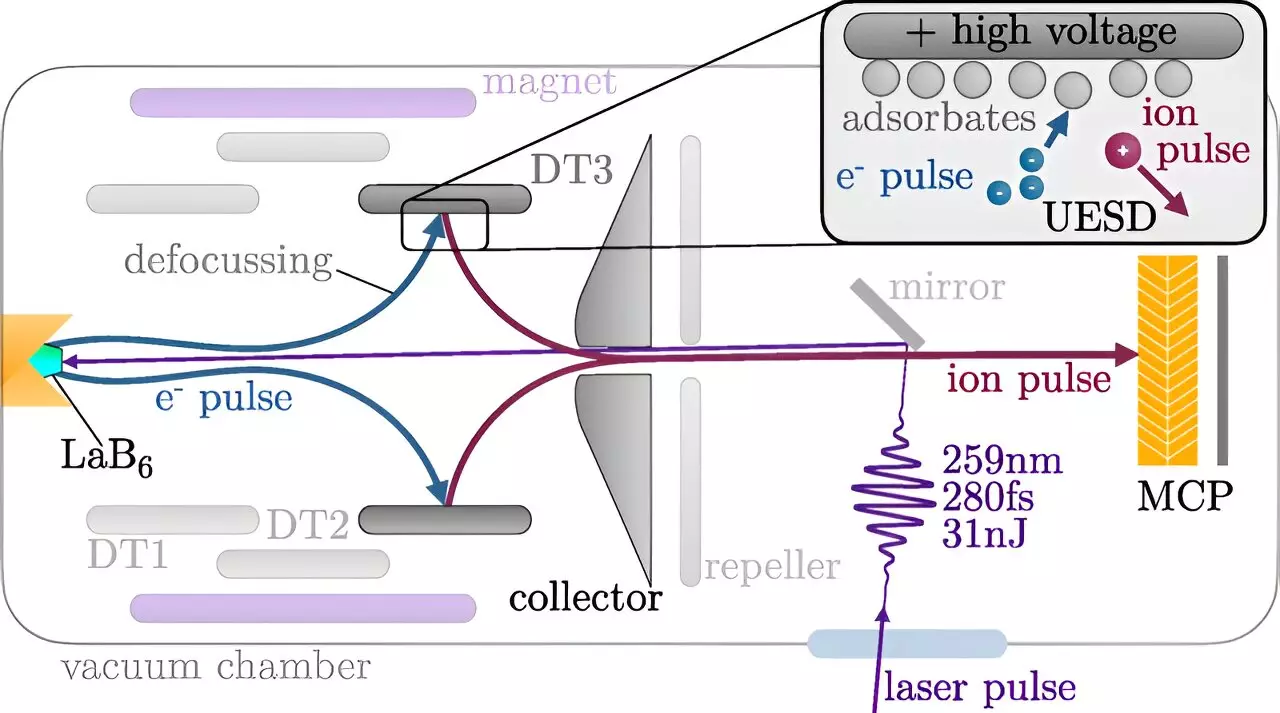In a compelling advancement in the field of applied physics, researchers at TU Wien (Vienna) have successfully developed a technique to generate laser-synchronized ion pulses with durations below 500 picoseconds. This groundbreaking achievement, detailed in the recent publication in *Physical Review Research*, offers new possibilities for the examination of chemical processes on material surfaces in real-time. The implications of this method are significant; as we delve into ultrafast processes, we can align our research closer to the realities of atomic interactions and material transformations.
In physics, just as a high-speed camera employs short exposure times to capture fleeting moments, the need for extremely brief ion pulses is paramount in studying ultrafast processes. Historically, laser pulses have dominated the exploration of rapid interactions at the atomic level, providing clarity on phenomena that transpire within atoms in mere attoseconds. However, the potential of ion pulses—charged particle beams—has often gone untapped. Until now, the challenge lay in producing sufficiently short ion pulses to trace the real-time effects of their interactions with material surfaces.
The innovation process employed by the TU Wien team is multi-faceted. They initiate their technique with a laser pulse directed at a cathode, resulting in electron emissions. These electrons are then accelerated to impact a stainless steel target, from which they eject atoms attached to the surface, such as hydrogen and oxygen. As outlined by Professor Richard Wilhelm from the Institute of Applied Physics, the ejected atoms include both neutral and ionized species. Through the application of electric fields, researchers can meticulously select the desired ions to form controlled ion pulses.
The pulses, which last approximately 500 picoseconds, enter a time frame that balances the boundary between practicality and precision, an ideal window for surface analysis. Comparing this duration to common scales of time illustrates the gravity of the accomplishment; within just 500 picoseconds, light only traverses about 15 centimeters. This advancement stands as a remarkable stride toward understanding fast-moving chemical processes while they actively unfold.
The implications of such fine-tuned ion pulse generation are manifold. One immediate application is the capability to probe chemical reactions in motion. The possibility of probing surfaces with ions at various intervals, while synchronizing them with laser-activated reactions, enables researchers to glean insights into the dynamics of chemical transformations. This novel approach not only enriches our understanding of surface chemistry but also enhances the analytical power of existing material characterization methodologies.
The research team is poised to extend its capabilities further. Currently harnessing basic protons for their ion pulses, they are exploring the potential to produce other ion types, including carbon and oxygen ions. By modulating the atoms layered on the stainless steel target, researchers can diversify the forms of ion pulses generated, expanding the scope of their investigations. Furthermore, they plan to refine their technique to generate even shorter ion pulses by employing specially shaped electromagnetic fields, representing another frontier in ultrafast studies.
The prospects of combining this novel ion pulse technique with ultrafast electron microscopy present additional layers of research potential. By integrating the two methodologies, scientists could achieve unparalleled insights into a variety of physical and chemical phenomena on surfaces. This synergy has the power to revolutionize how we visualize and understand rapid processes, pushing the boundaries of current scientific knowledge.
The introduction of laser-synchronized ion pulses at TU Wien signifies a monumental leap forward in the field of material science and physics. By capturing processes that occur on incredibly brief time scales, researchers stand on the brink of a new era of exploration. As the field continues to evolve, the ability to watch chemical reactions in real-time will undoubtedly open new avenues for technological advancement and a deeper understanding of the very fabric of matter. This research not only demonstrates the ingenuity of physicists at TU Wien but also sets a benchmark for future innovations that may fundamentally reshape our grasp of molecular dynamics.


Leave a Reply